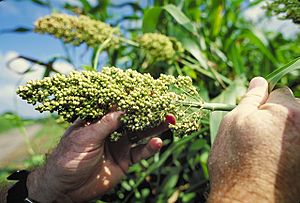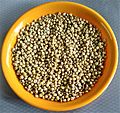Sorghum facts for kids
Quick facts for kids Sorghum |
|
|---|---|
 |
|
| S. bicolor | |
| Scientific classification |
|
| Kingdom: | Plantae |
| Clade: | Tracheophytes |
| Clade: | Angiosperms |
| Clade: | Monocots |
| Clade: | Commelinids |
| Order: | Poales |
| Family: | Poaceae |
| Subfamily: | Panicoideae |
| Supertribe: | Andropogonodae |
| Tribe: | Andropogoneae |
| Genus: | Sorghum Moench 1794, conserved name not Sorgum Adanson 1763 |
| Type species | |
| S. bicolor (L.) Moench
|
|
| Synonyms | |
|
|
Sorghum is a type of plant in the grass family. It is also known as broomcorn. There are about 25 different kinds, or species, of sorghum plants.
Some types of sorghum are grown as cereals, which means their grains are used for human food. Other types are grown as fodder to feed animals. Sorghum can also be used to make bristles for brooms. The grain is healthy, full of protein, dietary fiber, B vitamins, and important minerals.
Sorghum grows best in warm places around the world. It can also grow naturally in open plains. In 2021, the world produced 61 million tonnes of sorghum. The United States grew the most.
Contents
A Look at Sorghum's History
Sorghum was first grown by people over 5,000 years ago. This happened in the area we now call Sudan. The oldest proof comes from an old site near Kassala in eastern Sudan. It dates back to 3500 to 3000 BC. This shows it was a key food for the ancient kingdom of Alodia.
How Sorghum Plants Are Classified
Sorghum belongs to the grass family, called Poaceae. It is in a group called Panicoideae, and then a smaller group called Andropogoneae. Other well-known plants in this same group include maize (corn), big bluestem grass, and sugarcane.
Different Kinds of Sorghum
There are many accepted types of sorghum plants. Here are some of them:
- Sorghum amplum – found in northwestern Australia
- Sorghum angustum – found in Queensland, Australia
- Sorghum arundinaceum – found in Africa, India, Madagascar, and islands in the western Indian Ocean
- Sorghum bicolor – This is the most common type of cultivated sorghum. It's also called durra, jowari, or milo. It comes from the Sahel region of Africa but now grows in many places.
- Sorghum brachypodum – found in the Northern Territory of Australia
- Sorghum bulbosum – found in the Northern Territory and Western Australia
- Sorghum burmahicum – found in Thailand and Myanmar
- Sorghum controversum – found in India
- Sorghum × drummondii – found in Sahel and West Africa
- Sorghum ecarinatum – found in the Northern Territory and Western Australia
- Sorghum exstans – found in the Northern Territory of Australia
- Sorghum grande – found in the Northern Territory and Queensland
- Sorghum halepense – also known as Johnson grass. Found in North Africa, islands in the eastern Atlantic, and southern Asia. It now grows naturally in East Asia, Australia, and the Americas.
- Sorghum interjectum – found in the Northern Territory and Western Australia
- Sorghum intrans – found in the Northern Territory and Western Australia
- Sorghum laxiflorum – found in the Philippines, Lesser Sunda Islands, Sulawesi, New Guinea, and northern Australia
- Sorghum leiocladum – found in Queensland, New South Wales, and Victoria, Australia
- Sorghum macrospermum – found in the Northern Territory of Australia
- Sorghum matarankense – found in the Northern Territory and Western Australia
- Sorghum nitidum – found in East Asia, India, Southeast Asia, New Guinea, Micronesia
- Sorghum plumosum – found in Australia, New Guinea, and Indonesia
- Sorghum propinquum – found in China, India, Southeast Asia, New Guinea, Christmas Island, Micronesia, and Cook Islands
- Sorghum purpureosericeum – found in Sahel (from Mali to Tanzania), Yemen, Oman, and India
- Sorghum stipoideum – found in the Northern Territory and Western Australia
- Sorghum timorense – found in Lesser Sunda Islands, Maluku, New Guinea, and northern Australia
- Sorghum trichocladum – found in Mexico, Guatemala, and Honduras
- Sorghum versicolor – found in eastern and southern Africa (from Ethiopia to Namibia), and Oman
- Sorghum virgatum – found in dry areas from Senegal to the Levant.
Where Sorghum Grows
Out of the 25 types of sorghum, 17 are originally from Australia. Other types grow in Africa, Asia, Mesoamerica, and some islands in the Indian and Pacific Oceans.
How Much Sorghum Is Grown
In 2021, the world produced 61 million tonnes of sorghum. The United States grew the most, making up 19% of the total. India, Ethiopia, and Mexico were also big producers.
| Sorghum production – 2021 | |
|---|---|
| Country | (Millions of tonnes) |
| 11.4 | |
| 4.8 | |
| 4.4 | |
| 4.4 | |
| 3.3 | |
| 3.0 | |
| World | 61.4 |
| Source: FAOSTAT of the United Nations | |
Is Sorghum Safe?
When sorghum plants are very young, some types can have chemicals that are harmful to animals that eat them. These chemicals include hydrogen cyanide and nitrates. If the plants are stressed by not enough water or too much heat, they can also have dangerous levels of these chemicals even when they are older.
What's in Sorghum Grain?
Sorghum grain is healthy and can be eaten. When it's young and soft, you can eat it raw. But when it's mature, it needs to be boiled or ground into flour.
Sorghum grain is mostly carbohydrates (72%), including 7% dietary fiber. It also has 11% protein, 3% fat, and 12% water. A 100-gram serving of sorghum grain gives you 79 calories. It's also a great source of several B vitamins and important minerals.
| Nutritional value per 100 g (3.5 oz) | |
|---|---|
| Energy | 329 kJ (79 kcal) |
|
72.1 g
|
|
| Sugars | 2.53 g |
| Dietary fiber | 6.7 g |
|
3.46 g
|
|
| Saturated | 0.61 g |
| Monounsaturated | 1.13 g |
| Polyunsaturated | 1.56 g |
|
Protein
|
10.6 g
|
| Vitamins | Quantity
%DV†
|
| Vitamin A equiv. |
0%
0 μg |
| Thiamine (B1) |
29%
0.332 mg |
| Riboflavin (B2) |
8%
0.096 mg |
| Niacin (B3) |
23%
3.69 mg |
| Pantothenic acid (B5) |
7%
0.367 mg |
| Vitamin B6 |
34%
0.443 mg |
| Folate (B9) |
5%
20 μg |
| Vitamin C |
0%
0 mg |
| Vitamin E |
3%
0.5 mg |
| Minerals | Quantity
%DV†
|
| Calcium |
1%
13 mg |
| Copper |
14%
0.284 mg |
| Iron |
26%
3.36 mg |
| Magnesium |
46%
165 mg |
| Manganese |
76%
1.6 mg |
| Phosphorus |
41%
289 mg |
| Potassium |
12%
363 mg |
| Selenium |
17%
12.2 μg |
| Sodium |
0%
2 mg |
| Zinc |
18%
1.67 mg |
| Other constituents | Quantity |
| Water | 12.4 g |
|
Link to USDA Database entry
|
|
| †Percentages estimated using US recommendations for adults. | |
How People Use Sorghum
Archaeologists have found that sorghum was grown in ancient Sudan about 6,000 to 7,000 years ago. One type, S. bicolor, is originally from Africa. It is now grown all over the world for many uses. People use it for food (like grain or sorghum syrup), to feed animals, to make alcoholic drinks, and for biofuels.
In Nigeria, the crushed red leaves of sorghum have been used to dye leather. In Algeria, sorghum has been used to dye wool.
Special Compounds in Sorghum
All types of sorghum contain natural compounds called polyphenols. These include phenolic acids and flavonoids. Sorghum grains are one of the best food sources of proanthocyanidins.
Growing Sorghum
Most types of sorghum can handle dry weather and heat very well. They also use nitrogen efficiently from the soil. Because of this, they are often grown in dry or semi-dry areas. In these places, sorghum grain is a main food for people in poor or rural communities. These types of sorghum are also used as animal feed in many warm regions. S. bicolor is a very important food crop in Africa, Central America, and South Asia. It is the fifth most common cereal crop grown worldwide.
Sorghum and Trade
In 2013, China started buying sorghum from the United States. They used it to feed their livestock, along with corn grown in China. China imported about $1 billion worth of sorghum each year. However, in April 2018, China added extra taxes on US sorghum. This was part of a trade dispute between the two countries.
Images for kids
See also
 In Spanish: Sorghum bicolor para niños
In Spanish: Sorghum bicolor para niños



